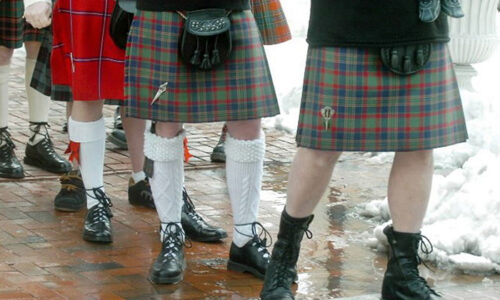1. Introduction
Highland cows, also known as Highland Cattle, are a distinctive breed of beef cattle originating from the rugged Scottish Highlands. Recognizable by their long, shaggy coats and impressive horns, Highland cows are not only a symbol of Scottish heritage but also a testament to the adaptability and resilience of livestock in harsh environments. These cows have been integral to Scottish farming practices for centuries, thriving in the harsh climate and rough terrain of their native region. Their unique appearance and history are matched by their practical benefits, which span across various sectors including agriculture, conservation, and tourism. Highland cows have proven to be versatile animals with a range of uses, each of which contributes significantly to sustainable practices and local economies. This blog explores the numerous ways Highland cows are utilized and the advantages they offer, providing insights into why they remain a valued breed in modern times.
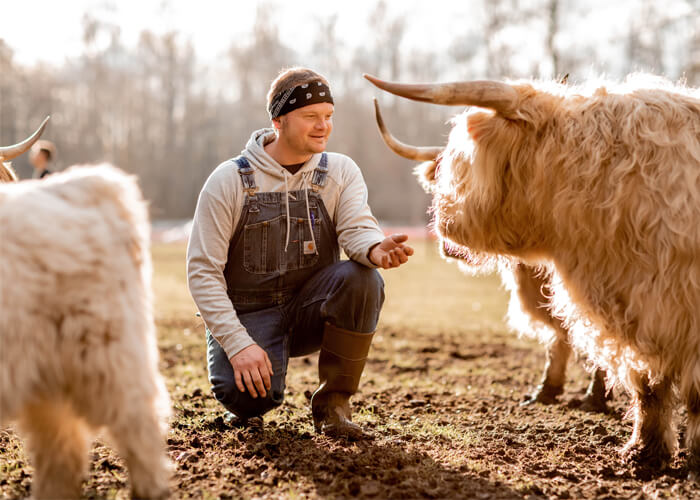
2. Sustainable Farming Practices
Role of Highland Cows in Promoting Sustainable Agriculture
Highland cows are ideally suited for promoting sustainable agriculture due to their ability to thrive on less-than-ideal pastures. Unlike more conventional cattle breeds that require lush, well-maintained grazing areas, Highland cows can effectively graze on rough, less nutritious grasslands. This characteristic makes them an excellent choice for extensive grazing systems where land is not necessarily optimized for high-yield farming. By using Highland cows, farmers can reduce their reliance on artificial feed and fertilizers, thereby minimizing their environmental footprint. The breed’s ability to graze on challenging terrain also means they can help manage large areas of land without the need for heavy machinery, which further reduces the carbon emissions associated with modern farming practices.
Benefits of Using Traditional Grazing Methods with Highland Cattle
Traditional grazing methods, which involve rotating cattle across different pasture areas, are highly beneficial when employed with Highland cattle. This approach prevents overgrazing and allows pastures to recover, which enhances soil health and plant diversity. Highland cows’ selective grazing habits help control the growth of invasive species and promote the regeneration of native grasses. This method of land management supports the health of the entire ecosystem by maintaining a balance between different plant species and fostering a habitat that benefits a wide range of wildlife. Furthermore, rotational grazing with Highland cattle contributes to soil fertility by allowing natural manure deposits to enrich the soil, reducing the need for synthetic fertilizers.
Contribution to Soil Health and Ecosystem Balance
The presence of Highland cows has a positive impact on soil health and ecosystem balance. Their grazing behavior helps to aerate the soil, which improves its structure and enhances its ability to retain moisture. This process reduces soil erosion and promotes better water infiltration, leading to healthier and more resilient pastures. Additionally, Highland cows’ manure acts as a natural fertilizer, adding essential nutrients to the soil and supporting the growth of diverse plant species. By maintaining a balanced plant community, Highland cattle contribute to the overall biodiversity of their environment. Their grazing also helps to prevent the dominance of a few plant species, which is crucial for sustaining a diverse and balanced ecosystem.
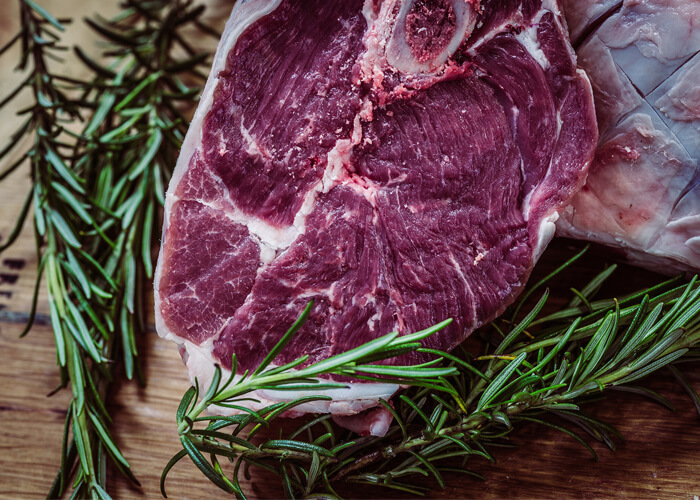
3. High-Quality Meat Production
Overview of the Meat Quality Produced by Highland Cows
Highland cattle are renowned for producing high-quality beef that is prized for its flavor and tenderness. The meat from Highland cows is known for its fine marbling, which imparts a rich taste and juicy texture. Unlike some other breeds, Highland cattle have a unique ability to develop a high level of intramuscular fat, which enhances the flavor profile of their beef. This marbling not only contributes to a more enjoyable eating experience but also helps to retain moisture during cooking, resulting in a tender and succulent product. Highland beef is often considered superior due to its distinctive taste and texture, which can be attributed to the breed’s natural grazing habits and the quality of its diet.
Discussion on the Growing Popularity of Grass-Fed Beef Among Consumers
The popularity of grass-fed beef has been on the rise as consumers become more health-conscious and environmentally aware. Grass-fed beef, including that from Highland cattle, is often sought after for its perceived health benefits and ethical production methods. Unlike conventionally raised beef, which may be fed grain-based diets and treated with antibiotics or hormones, grass-fed beef is produced from cattle that graze on natural pastures. This method of production is associated with lower levels of total fat and saturated fat, as well as higher concentrations of beneficial nutrients such as omega-3 fatty acids and antioxidants. As consumers increasingly prioritize sustainable and ethical food choices, Highland beef is gaining recognition for its quality and the advantages of grass-fed production.
Nutritional Benefits Associated with Eating Highland Beef
Highland beef offers several nutritional benefits that make it a valuable addition to a healthy diet. The meat is lower in total fat and saturated fat compared to beef from conventionally raised cattle, which can contribute to better cardiovascular health. Additionally, Highland beef is rich in omega-3 fatty acids, which are essential for heart health and have anti-inflammatory properties. The beef also provides important vitamins and minerals, such as iron, zinc, and vitamin B12, which are necessary for overall health and well-being. The unique nutritional profile of Highland beef reflects the breed’s natural diet and the health benefits associated with grass-fed production.
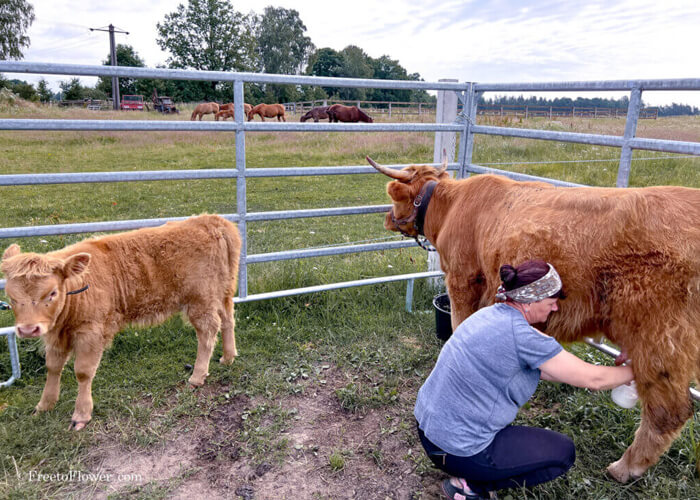
4. Milk Production Alternatives
Insight into the Dairy Potential of Highland Cattle
Although Highland cattle are primarily known for their beef production, they also have potential in dairy farming. While they are not as prolific in milk production as specialized dairy breeds, Highland cows can produce a respectable amount of milk. This milk is often used for niche dairy products rather than large-scale commercial production. The dairy potential of Highland cattle lies in their ability to produce milk with a high butterfat content, which is ideal for making rich and creamy dairy products. The breed’s adaptability to different grazing conditions and its ability to thrive on less-than-ideal pasture also contribute to its potential as a dairy producer.
Comparison Between Highland Milk and Other Dairy Breeds
Highland milk differs from that of other dairy breeds in several ways. While the total milk yield may be lower compared to breeds like Holsteins or Jerseys, Highland milk is known for its higher butterfat content. This characteristic makes it particularly well-suited for producing rich and creamy dairy products, such as artisanal cheeses and specialty butters. The flavor and composition of Highland milk can vary depending on the cow’s diet and management practices. Although it may not match the production volume of more conventional dairy breeds, Highland milk offers unique qualities that can be leveraged for niche markets and high-value dairy products.
Opportunities for Artisanal Cheese and Specialty Dairy Products
The rich and creamy milk produced by Highland cows presents opportunities for creating artisanal cheeses and specialty dairy products. Small-scale dairy operations can use Highland milk to produce unique cheeses, yogurts, and other dairy items that cater to niche markets. The high butterfat content of Highland milk contributes to the development of cheeses with distinctive textures and flavors. Artisanal cheese makers can highlight the unique characteristics of Highland milk in their products, appealing to consumers who seek high-quality, locally-produced dairy items. The production of specialty dairy products from Highland Milk offers an opportunity to create premium products that stand out in the market.
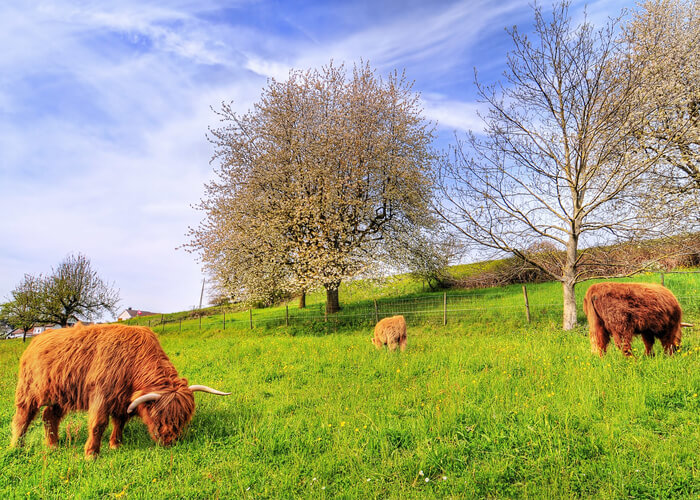
5. Conservation Grazing
Importance of Highland Cows in Habitat Management and Conservation Efforts
Highland cows play a crucial role in habitat management and conservation efforts. Their grazing helps to maintain and restore natural habitats, such as heathlands, grasslands, and wetlands. By controlling vegetation growth, Highland cattle support the preservation of diverse plant species and prevent the encroachment of shrubs and trees that can alter the natural landscape. This management approach is particularly important in conservation areas where maintaining the natural habitat is essential for supporting a range of plant and animal species. Highland cattle’s ability to graze on challenging terrain makes them a valuable tool for managing and conserving natural environments.
Examples of Successful Conservation Projects Utilizing Highland Cattle
Several successful conservation projects have utilized Highland cattle to manage and restore natural habitats. One notable example is the Knepp Estate in England, where Highland cows have been used as part of a rewilding project to enhance biodiversity and promote natural processes. The presence of Highland cattle has helped to manage the landscape, support plant diversity, and create habitats for various wildlife species. Another example is the use of Highland cattle in the Scottish Highlands to manage moorland and prevent the overgrowth of invasive plant species. These projects demonstrate the effectiveness of using Highland cattle in conservation grazing and habitat management.
How They Help Maintain Biodiversity in Fragile Ecosystems
Highland cattle contribute to biodiversity by supporting a diverse range of plant and animal species. Their grazing helps to maintain a balanced plant community, which in turn supports various insects, birds, and small mammals. By preventing the dominance of a few plant species, Highland cattle create a more resilient and diverse ecosystem. In fragile ecosystems, such as wetlands or heathlands, the presence of Highland cattle helps to sustain the delicate balance needed to support diverse wildlife. Their grazing practices contribute to the overall health and resilience of the ecosystem, making them an important component of conservation efforts.
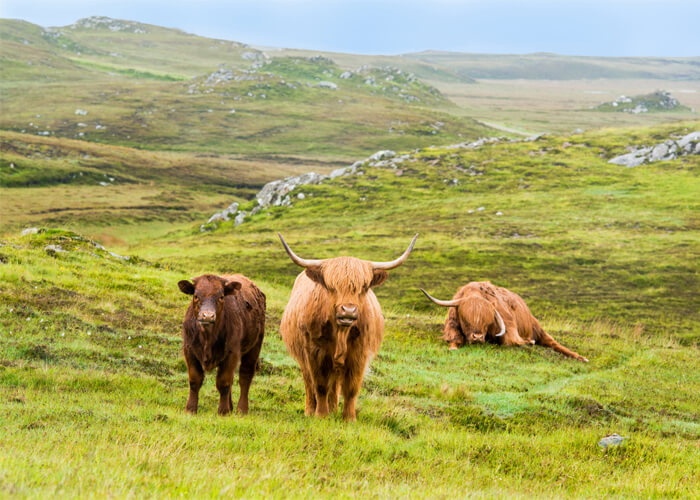
6. Unique Landscaping Solutions
The Aesthetic Appeal of Using Highland Cows as Part of Landscaping Designs
Highland cows offer a unique aesthetic appeal when integrated into landscaping designs. Their distinctive appearance and gentle demeanor make them an attractive addition to rural landscapes and open spaces. The sight of Highland cattle grazing in picturesque settings can enhance the visual appeal of parks, nature reserves, and other public spaces. Highland cows add a pastoral charm to landscapes, creating a sense of tranquility and connection to nature. Their presence can transform ordinary spaces into picturesque and inviting environments, making them a popular choice for landscape designers and park managers.
Advantages Over Mechanical Land-Clearing Methods
Using Highland cows for land management offers several advantages over mechanical methods such as bush hogging or mowing. Highland cattle provide a natural, low-impact alternative for managing vegetation. Their grazing helps to control plant growth and prevent the overgrowth of invasive species without the need for heavy machinery. This approach reduces soil disturbance and minimizes the risk of erosion compared to mechanical land-clearing methods. Additionally, Highland cows’ presence contributes to the ecological balance of the area by supporting a diverse plant community and creating habitats for wildlife. Their grazing also avoids the noise and pollution associated with mechanical equipment.
Case Studies Showing Effective Use in Parks and Open Spaces
Several case studies highlight the effective use of Highland cattle in parks and open spaces. For example, the City of Edinburgh has employed Highland cattle to manage vegetation and maintain the natural beauty of its parks and green spaces. The cattle’s grazing has helped to enhance biodiversity and create a more visually appealing environment. Another example is the use of Highland cattle in the Longleat Estate in England, where they contribute to the management of parkland and the preservation of traditional landscapes. These case studies demonstrate the versatility of Highland cattle in landscaping and their ability to enhance the aesthetic and ecological value of public spaces.
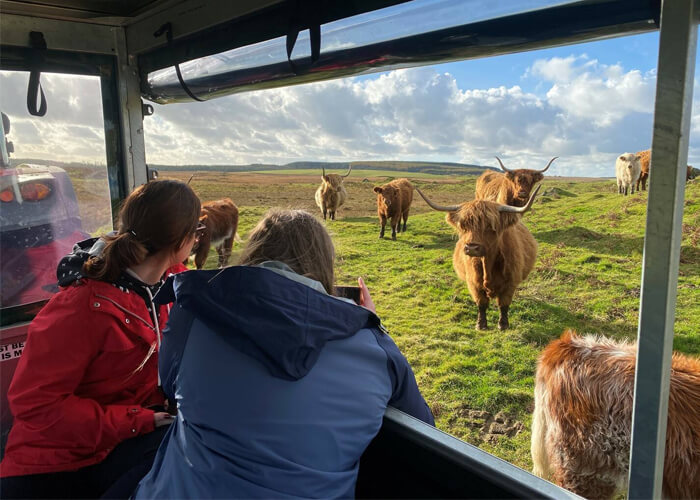
7. Cultural Heritage and Tourism
Exploring the Cultural Significance Tied to Highland Cattle Farming Practices
Highland cattle hold significant cultural value in Scotland and beyond. Their farming practices are deeply rooted in Scottish history and tradition, reflecting a way of life that has been preserved for centuries. The breed is associated with the rugged landscapes of the Scottish Highlands and the traditional farming practices that have shaped the region. Highland cattle are celebrated as symbols of Scottish heritage, and their distinctive appearance contributes to the cultural identity of the region. The ongoing tradition of Highland cattle farming is an important aspect of Scotland’s cultural heritage, representing a connection to the past and a commitment to preserving traditional practices.
Impact on Tourism Through Farm Visits, Events, and Festivals
Highland cattle have a notable impact on tourism, attracting visitors to farms, events, and festivals that showcase these iconic animals. Farm visits offer tourists the opportunity to experience Highland cattle up close and learn about their role in farming and conservation. Events such as Highland Games and agricultural fairs often feature Highland cattle as part of the festivities, drawing crowds and promoting local traditions. Festivals celebrating Scottish heritage and rural life highlight the importance of Highland cattle in the cultural landscape. These tourism activities not only provide an educational experience but also contribute to the local economy by attracting visitors and supporting rural businesses.
Role in Promoting Rural Economies and Local Traditions
Highland cattle play a significant role in promoting rural economies and preserving local traditions. The breed’s association with traditional farming practices and cultural heritage attracts visitors and supports local businesses. Farm tours, specialty food products, and cultural events centered around Highland cattle contribute to the economic vitality of rural areas. By showcasing the breed’s unique characteristics and the traditional practices associated with their management, Highland cattle help to promote rural tourism and support local economies. The continued interest in Highland cattle and their cultural significance underscores the importance of preserving traditional farming practices and supporting rural communities.
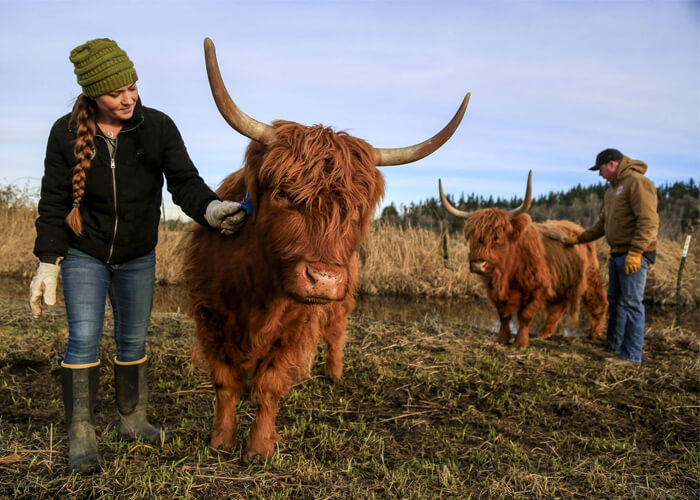
8. Educational Opportunities
How Farms Raise Awareness About Livestock Cultivation Through Educational Programs Involving Highland Cows
Farms that raise Highland cattle often use them as part of educational programs to raise awareness about livestock cultivation and sustainable farming practices. These programs provide valuable learning experiences for students, educators, and the general public. Through hands-on activities and interactive demonstrations, participants gain insights into animal husbandry, grazing management, and the role of livestock in sustainable agriculture. Educational programs involving Highland cattle can include farm tours, workshops, and demonstrations that cover topics such as animal care, pasture management, and conservation practices. These programs foster a greater understanding of the agricultural industry and promote responsible farming practices.
Internships or Workshops Tailored for Students Interested in Agriculture or Animal Husbandry Principles
Students interested in pursuing careers in agriculture or animal husbandry can benefit from internships and workshops focused on Highland cattle. These opportunities provide practical experience and in-depth knowledge about managing livestock and implementing sustainable farming practices. Internships on farms that raise Highland cattle offer hands-on training in areas such as animal care, pasture management, and conservation grazing. Workshops and seminars tailored for students can cover a range of topics, including breeding, nutrition, and health management. These educational experiences prepare students for careers in agriculture and provide them with valuable skills and insights into the livestock industry.
9. Conclusion
Highland cows offer a multitude of benefits that extend beyond their traditional roles in farming. Their contributions to sustainable agriculture, high-quality meat production, and conservation efforts highlight their versatility and value in modern agriculture. The breed’s unique characteristics also make it an attractive option for landscaping and cultural tourism, adding aesthetic and economic value to rural areas. Additionally, Highland cattle provide educational opportunities for students and enthusiasts, fostering a greater understanding of livestock management and sustainable practices. As interest in Highland cows continues to grow, there are numerous opportunities to explore their potential and appreciate their diverse contributions to our world. Whether through farming, conservation, or tourism, Highland cattle offer valuable benefits that enrich both the environment and our communities.
Frequently Asked Questions (FAQs) about Highland cows:
Highland cows are renowned for their distinctive appearance, characterized by their long, shaggy coats and impressive horns. They are also known for their resilience and adaptability to harsh weather conditions, which makes them well-suited for rugged terrains. In addition to their unique looks, Highland cows are valued for their high-quality beef and their role in sustainable farming and conservation grazing.
Highland cattle contribute to sustainable farming by thriving on less-than-ideal pastures and participating in rotational grazing systems. Their ability to graze on rough, less nutritious land reduces the need for artificial feed and fertilizers, which minimizes environmental impact. Their grazing habits also help maintain soil health, prevent erosion, and support biodiversity by managing vegetation without heavy machinery.
Highland beef is known for its superior flavor and tenderness due to its fine marbling. The breed’s natural grazing habits result in beef with a higher level of intramuscular fat, which enhances the taste and juiciness of the meat. Additionally, Highland beef is often grass-fed, leading to a leaner product with higher concentrations of omega-3 fatty acids and other beneficial nutrients.
While Highland cows are primarily raised for beef, they can also be used for milk production. However, they are not as prolific in milk yield as specialized dairy breeds. Highland milk is noted for its high butterfat content, making it suitable for producing rich dairy products like artisanal cheeses and specialty butter. The milk’s quality and flavor are distinct from that of more conventional dairy breeds.
Highland cows are instrumental in conservation grazing, where they help manage and restore natural habitats. Their grazing prevents the overgrowth of invasive plant species and supports a diverse plant community, which in turn benefits wildlife. By maintaining habitats such as heathlands and grasslands, Highland cattle contribute to biodiversity and ecosystem health.
Highland cows are used in landscaping and park management to provide natural land management solutions. Their grazing helps control vegetation, reducing the need for mechanical land-clearing methods. This approach minimizes soil disturbance and supports ecological balance while adding a picturesque and pastoral element to parks and open spaces.
Highland cows hold significant cultural value in Scotland, where they are a symbol of traditional farming practices and heritage. They are celebrated in Scottish culture and feature prominently in events such as the Highland Games and agricultural fairs. Their presence supports rural tourism and contributes to the preservation of local traditions and cultural identity.
Yes, there are various educational opportunities related to Highland cattle. Farms often offer programs and workshops that provide insights into livestock management, sustainable farming practices, and conservation grazing. Additionally, internships and hands-on training programs are available for students interested in agriculture or animal husbandry, offering practical experience with Highland cattle.


